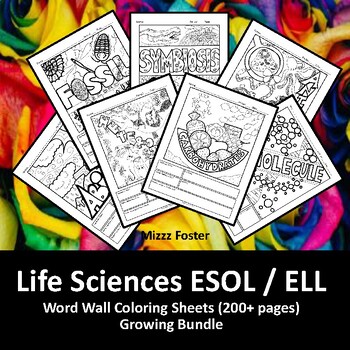Life Sciences ESOL / ELL 200+ Word Wall Coloring Posters: Biology & Anatomy
- Zip
What educators are saying
Description
This collection includes 200+ Life Science terms with student prompts designed for students in ESOL, ELL, and ELA classes. The students will write the Science term in English as well as their native language. The last prompt is for writing the vocabulary term in a complete sentence. As this is a growing bundle I will continue to add more words.
This set includes words from Life Sciences such as Biology, Human Anatomy, and Environmental Science.
Each word wall poster features a coloring section for students, alongside designated areas for the ELL to write the vocabulary word and its definition in English, and in their native language. The fifth box is a prompt for the students to write a sentence using the vocabulary word.
Explore a world of scientific discovery with my hand-drawn engaging Educational Science Coloring Pages. These meticulously designed sheets are more than just coloring fun; they introduce scientific terminology in a captivating manner, making them perfect for both STEM (Science, Technology, Engineering, and Mathematics) and STEAM (Science, Technology, Engineering, Arts, and Mathematics) education. My science coloring pages are an ideal resource for students of all ages, combining creativity and learning to foster a deep understanding of scientific concepts. Dive into the world of science with our innovative coloring materials today!
Coloring pages have gained immense popularity worldwide. Explore my latest series of Science word wall coloring pages to infuse color and engagement into your middle and high school science classes.
Word Walls, initially an elementary teaching tool, has proven successful when incorporated into secondary education. My administrators encouraged its use in our classrooms, leading to remarkable outcomes. Students embraced the task of designing word wall displays, fostering pride in their contributions. This dynamic display sparked interaction as students admired each other's creations. Over time, I observed students frequently glancing at the word wall, particularly during spontaneous quizzes or warm-up exercises. The word wall bolstered their retention of vocabulary, providing a constant reference point. Not only do the word walls teach students, but they also give students a pathway to create Scientific decoration for their learning environment.
To assist students struggling with word wall activities, I developed coloring pages. While self-motivated artists can opt for a blank template, these coloring pages offer a creative outlet for those seeking guidance.
I've found word walls particularly effective post-tests, for introducing new vocabulary in a relaxed manner, as substitute assignments, and for extra credit. They also serve as an enjoyable means to revisit challenging words.
Don't hesitate to share your students' work on Instagram and tag me, @MizzzFoster.
WORDS:
Abiotic
Allele
Amino Acid
Analogous Organs
Animals
Anaphase
Aquatic
Archaebacteria
ATP
Atom
Autotroph
Benign Tumor
Biogeography
Biomes
Biomolecules
Biotic
Boreal Forest / Taiga
Carbohydrate
Carbon Dioxide
Cave
Cell Checkpoints
Cell Cycle
Cell Membrane
Cells
Cellular Respiration
Cell Wall
Centrioles
Charles Darwin
Chemical Energy
Chloroplast
CHNOPS
Chromosomes
Circadian rhythm
Circulatory System
Class
Codon
Commensalism
Comparative Anatomy
Control Center
Convergent Evolution
Covalent Bond
CO2
Crossing Over
Cytokinesis
Cytoplasm
Dehydration Synthesis
Desert
Digestive System
Dihybrid
Diploid
Divergent Evolution
DNA
DNA Evidence
DNA replication
DNA translation
DNA transcription
Domain
Dominant
Ecological Niche
Ecosystem
Effector
Embryology
Endocrine system
Endoplasmic Reticulum
Endosymbiosis
Endothermic
Energy
Estuary
Eubacteria
Eukaryote
Evolution
Excretory system
Exothermic
Family
Fatty Acid
Female reproductive system
Forest
Fossil
Freshwater
Fungi
Gamete
Genetic Flow
Genotype
Genus
Glucose
Glycolysis
Golgi Apparatus
Grassland
Haploid
Heterotroph
Heterozygous
Homeostasis
Homologous Organ
Homozygous
Host
Hydrogen Bond
Hydrolysis
Integumentary system
Interphase
Kingdom
Krebs Cycle
Light Dependent
Light Independent
Light Energy
Lipid
Lymphatic system
Lysosomes
Male reproductive system
Malignant Tumor
Marine Water
Meiosis
Metaphase
Microtubules / Microfilaments
Mitochondria
Mitosis
Monohybrid
Monomer
mRNA
Multicellular
Muscular system
Mutualism
Natural Selection
Negative Feedback
Nervous system
Nonpolar
Nucleic Acid
Nucleotide
Nucleus
Order
Organ
Organelle
Organism
Organ system
Oxygen
Parasitism
Peroxisome
pH
Phenotype
Phospholipid
Photosynthesis
Phylum
Plants
Polar
Polymer
Polymerase
Population
Population Genetics
Positive Feedback
Predation
Prokaryotes
Prophase
Protein
Protista
Receptor
Recessive
Respiratory System
Ribosomes
Ribosome (for DNA translation)
RNA
Single Cellular
Skeletal System
Species
Stimuli
Symbiosis
Synapsis
Taxonomy
Telophase
Temperate Forest
Tissue
tRNA
Tropical Forest
Tundra
Vacuole
Vesicle
Vestigial Organ
Water
Wetlands
Related Resources:
Science Posters 290+ Word Wall Coloring Sheets: Biology, Chemistry, Physics
Science ESOL / ELL 290+ Word Wall Coloring Sheets: Biology, Chemistry, Physics





